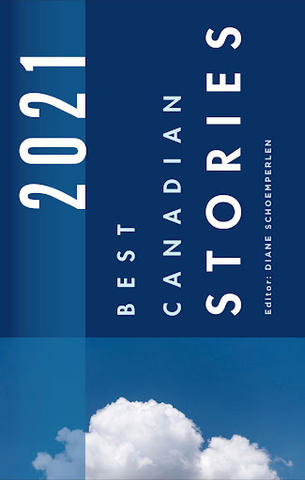
Review by Meghan Kemp-Gee
Best Canadian Stories 2021
Biblioasis, 2021
Remember the incapacitating “brain fog” that troubled so many of us during the COVD-19 lock-downs of 2020 and 2021?
(Maybe you don’t, because…well, brain fog. Or maybe you do, because we’re still in the midst of a global pandemic and you’re still very much fogged up.)
In her introduction to Best Canadian Stories 2021, editor Diane Schoemperlen describes her own experience of “brain fog” this way:
"Although my love of reading had helped me through many crises in my life, now I found it too had mostly deserted me. [...] My concentration and attention span had dwindled to the point where I no longer had the bandwidth to read more than ten or twenty pages at a stretch. [...] I finally realized short stories could be the perfect antidote to this problem."
In Best Canadian Stories 2021, Schoemperlen collects fifteen short stories that are nearly ideal examples of the kind of “antidote” she prescribes for these Unprecedented Times™: short, strange, diverting, captivating, transcendent, and diverse.
As I read these fifteen stories, however, I kept ruminating on her introduction—and not just her suggestion that readers can utilize the short story to snap or soothe ourselves out of our general malaise. It was this passage that I couldn’t get out of my mind:
"On many April mornings, with the familiar and reassuring signs of spring outside and me happily settled in my reading chair with Chekhov, a cup of coffee, and a cat or two, there would come the sound of a helicopter flying low over my house, bringing COVID patients to the Kingston hospital from cities whose own hospitals were filled beyond capacity."
Schoemperlen is suggesting a specific aesthetic way to read, appreciate, and define the Canadi-an short story in 2021. On the one hand, this mindset might seem a bit escapist or even cal-lous—retreating into cozy literary comfort while apocalyptic suffering happens somewhere in the distance. But I don’t think that’s exactly what she’s advocating here. After reading the short sto-ries she’s selected for this volume, I think they’re also linked by a similar aesthetic sensibility, rhythm, and context: a strange existential contrast and marriage between extremes.
I’m not just talking about juxtaposition—although this volume certainly supplies that in abun-dance. Life and death, love and hate, intimacy and danger, domestic and alien are in tension in one way or another in every story. Some combination of Schoemplerlen’s tastes and our bewil-dering New Normal™ have created stories in which extremes don’t just contrast but intertwine and knit together new life in strange, unexpected ways. The pandemic was (is?) weird and trau-matic not just because everything was singular and unprecedented, but because everything was so predictable at the same time. Lockdown, reopening, surge, lockdown, rinse, repeat. Nothing is surprising, and everything is.
Lucia Gagliese’s “Through the Covid Glass” is the only story in BCS2021 to engage explicitly with the pandemic. As the narrator struggles with her job as a remote therapist for frontline health workers, she echoes the collection’s editor’s uneasy role as observer of a global emergency:
"I am safe, but my colleague-patients are on the front lines, battling this demon. Their lives shattered, they live in terror, yet persist. [...] As the weeks and months pass, my colleague-patients blend; their stories about their patients blend. Some-times I can’t tell them apart. I am safe, but I am hiding."
To borrow a word from Gagliese, blending might be a good description of the thread that I imag-ine connecting and defining these stories. Shoemperlen assembles these stories from a variety of sources: literary journals, emerging writers, well-known names; however, she takes a calcu-latedly hands-off approach to arranging them in any deliberate sequence. I really appreciated Shoemperlen’s decision to arrange the collection arbitrarily, in alphabetical order, which we could read as a very 2021 screw it, we’ll do it live vibe, but also as a way of enhancing this aesthetic of tension, of expected unexpected stasis and event. As you read linearly or nonlinearly through this sequence of stories, connections and (un)happy confluences between the story spring up by chance or by your own will.
As I read, I noted many examples of these serendipitous patterns, spikes and connections.
Two adjacent stories (Megan Callahan’s “Good Medicine” and Francine Cunningham’s “Asleep Till You’re Awake”) take place in walk-in clinics, as protagonists hover between health and sick-ness.
Three stories (Cunningham’s “Asleep Till You’re Awake,” Angélique Lalonde’s “Lady With the Big Head Chronicle,” Sarah O’Leary’s “The Ones We Carry With Us”) feature some kind of ghost or undead haunting a protagonist veering between life and afterlife.
The collection begins with three stories in a row that are about “love”—or what should be love, but is in fact an occasion for violence and danger of some kind. In “Let’s Play Dead,” Senaa Ahmad’s zombie Ann Boleyn survives a tragicomic litany of Henry VIII’s increasingly bizarre as-sassination attempts; Ahmad’s canny/uncanny use of repetition and dark humour underline how survival is, on some level, a repetitive and monotonous grind. (Get beheaded four times, get up five.) Chris Bailey’s understated “What Would You Do?” is a troubled love story that deftly ends just as it tips over into mortal danger, while Shashi Bhat’s fabulous “Facsimile” veers breathtak-ingly between unsatisfying, boring first dates and moments of bizarre singularity: there are sharks in every photograph, moose in the local coffee shop.
Veering might be a good word for how these stories move between precarious tension and sur-prise. You could read almost every story in this collection as a series of fragments, quotidian monotony, a low drumbeat of danger punctuated by sudden uncanniness, tragedy, or revelation.
Callahan’s “Good Medicine” enacts a precarious pattern of recovery and relapse as its protago-nist adjusts her anxiety medication; Colette Maitland’s terrific “Downsizing” juxtaposes the humil-iating everyday compromises and nasty daggers of a terrible marriage. Don Gillmor’s unsettling extramarital affair in “Dead Birds” finds danger everywhere in the mundane, from the threat of pens in a rare books archive to the ongoing theme of the “American trait” of wanting to kill and love something at the same time.
In Jasmine Sealy’s “Collapse,” one character compares this omnipresent sense of danger to “lightning striking the house next door. It makes life feel so… fragile.” But Sealy’s narrative ulti-mately disputes this character’s perception; death, disruption, and fracture aren’t just a disaster, but an opportunity for connection, reconnection, and even homecoming.
This feeling of rapid-fire monotony, of fragments threatening to veer into dangerous territory, consistently manifests in these short stories’ form and language. Cunningham’s staccato sen-tences and devastating fragments beat out the mundane rhythms of life and death, like gunfire or helicopter wings: “My mom. No, I should say my dead mom.” Joshua Wales’ “Lightness” uses exhilarating jumps in time to enact a lifetime of heartbreak. The structure of Elise Levine’s dev-astating “Arnhem” picks up the episodic rhythm of its main characters’ hitchhiking across Eu-rope, their undifferentiated dialogue always hovering between intense intimacy and the unspeak-able traumas simmering beneath the surface. In “Lady With the Big Head Chronicle” (which I consider the standout story in the collection), Lalonde’s title character is an otherworldly cryptid, but Lalonde also writes in otherworldly fragments, ghost-like episodes. Her language is a prose-poetry hybrid that flits in and out of focus like a microcosm of this collection—and perhaps a mi-crocosm of this world, this year:
"The lady with the big head is a little bit like a medium between us and this world. We fumble toward knowing one another with our gifts and intentions, undaunted by our failures to understand one another. Thrilled by the revelations that come."
Although I don’t want to spoil a truly transformative ending—to a story or to a remarkable short story collection—I think that the last line of Joy Waller’s “Shinjuku for Stray Angels” couldn’t work any better in this context. Waller sets her fragmented love story in a strange, piecemeal version of Tokyo—a place made up of fast food and moonlit parks, but also inhabited by foreboding im-aginary snakes and wolves. But we’re at home in this place of contrast, fragments, precarity, and impending fracture. After everything, “We don’t feel lost.”










Add new comment